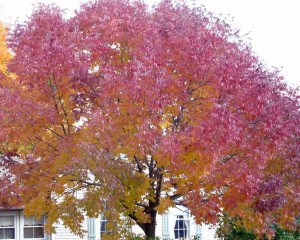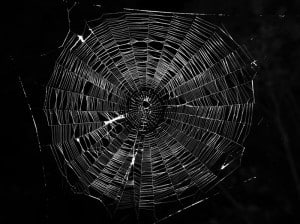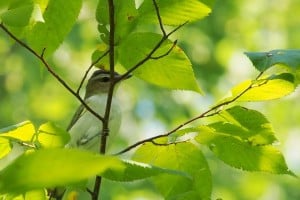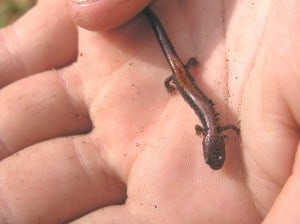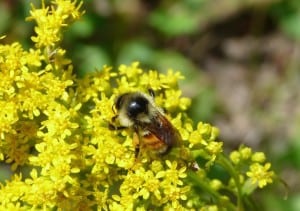“From dewy lanes at morning
The grapes’ sweet odors rise;
At noon the roads all flutter
With yellow butterflies
By all these lovely tokens
September days are here,
With summer’s best of weather,
And autumn’s best of cheer”
– Helen Hunt Jackson
This week, I would like to propose some activities for people of all ages to more fully enjoy the wonderful month of September. They are part of an up-coming book on seasons-based nature activities that I am writing with Jacob Rodenburg, Executive Director of Camp Kawartha.
A September walk
We’ve known for a long time how beneficial walking is to our physical health. Now, we are becoming increasingly aware of huge benefits to our mental health, as well. Daily walking enhances concentration, creativity, mood and general psychological well-being. Here are some ideas to add a dose of nature to your daily walk.
1. Watch how a specific tree changes colour over the course of this month and next.
2. Collect leaves of different shapes and colours and try to identify them when you get home.
3. Take note of the health of the trees. Do you see dead crowns, diseased leaves, “tar spot” fungus on maple leaves, fall webworm “nests” on the branches, etc.?
4. Pay attention to the amount of fruit – seeds, berries, acorns, keys, and the like – on trees and shrubs. It varies considerably from one year to the next.
5. Listen to the steady background of the insect chorus. How many different voices can you hear?
6. Take note of the absence of bird song. Listen, however, for the calls of Blue Jays and crows.
7. Pay attention to smells such as sun-heated vegetation and fallen pine needles.
8. Keep an eye out for squirrels digging holes in the lawn to store food items.
9. Watch for flocks of birds. By September, even robins are usually in flocks.
10. On hot, muggy days, watch for swarms of mating ants milling about on the sidewalk and flying overhead.
“Pish” in birds
If you’d like to see birds close up, try this activity. When you hear chickadees calling, stop and make loud “pishing” noises for a minute or two. Pishing consists of making the sound “shhhh” but adding a “p” in front. You will be amazed as chickadees and nuthatches often approach to within one or two metres of you. Don’t stop then, however, because migrating vireos and warblers are probably also present but are usually just a little slower to approach. Although some of the warblers are sporting their dull fall plumage, others look surprisingly like they did in the spring and are therefore easy to identify. Look for distinctive markings such as eye rings, splashes of colour and stripes. Don’t expect to identify everything. You can see and hear pishing in action by going to YouTube and searching “pshing!”
It’s feeder time
If you want a close-up look at some of the migrant sparrows passing through in early fall, September is the time to set up your feeders. Be sure to also scatter some niger seed or finch mix in small piles on the grass under your feeder and around the edge of shrubs and conifers. These will attract Dark-eyed Juncos, along with both White-throated and White-crowned sparrows. You can also scatter sunflower seeds about if you don’t mind losing some to the squirrels! Many of the sparrows will be juveniles making their first migration south. Use your field guide to learn the differences between adult and juvenile birds.
Salamander sleuthing
Hunting for salamanders is great fun. They are most commonly found in low-lying wooded areas or around country homes and cottages. Look under fallen logs, old boards, and flat rocks and even in old piles of firewood. Carefully lift up the rock or piece of wood and peak underneath. The most common species are the Spotted, Blue-spotted and Red-backed. If you find a salamander, observe the counter shading (darker on top and lighter underneath). Notice, too, how stream-lined they are – slim and flat – for fitting into tight nooks and crannies. Red-backed salamanders can resemble earthworms, so be sure to look carefully. After you’ve examined them and maybe taken a picture or two, carefully put the rock, board or log back just the way you found it. Please be careful not to crush the animal.
Close-up with insects
Take time this month to see how many different insects and other invertebrates you can find in a patch of goldenrod. Don’t worry if you can’t identify them all; just focus on the diversity. Pay special attention to the bees. You should be able to see the large, yellow pollen baskets on their hind legs. Watch, too, for insects that haven’t moved for a long time, because they may still be in the clutches of a well-camouflaged predator like an ambush bug or a crab spider. To be comfortable, you might also want to bring a lawn chair. Don’t forget your camera, either, because you should be able to get some great pictures, especially by taking advantage of the macro settings. If you are worried about allergies, remember that ragweed pollen is the allergen to be concerned about. Goldenrod pollen is not spread through the air, being far too heavy. Rather, it is spread by insects. Don’t worry about getting stung, either. You can get right into an insect’s face with your camera with almost no danger of being bitten. BugGuide.net is an excellent on-line resource. You can even post pictures for identification purposes.
Catch a spider web
Locate an easy-to-access web. Apply a spray adhesive to a piece of black construction paper or cardstock. With the black paper behind the web, slowly bring the paper towards you until it touches the web. Then, with the web on the paper, carefully cut the guy-lines holding the web in place. On the back of the paper, you can make a note of the date, location, type of web and the species of spider that made it.
A rainbow hike
This activity will help you to see and appreciate the multitude of leaf colours produced by different trees, shrubs and other plants in autumn. Try to obtain some paint chip samples (e.g., yellows, reds, oranges, greens, browns, rusts, etc.) from a hardware store. Provide each member of the group with an assortment of different coloured chips. As you are walking, try to find a leaf that matches as many of the chips as possible. You may wish to collect the leaf, photograph it or simply show it to the other members of the group.
Measure your shadow
On a sunny day close to the fall equinox, go outside at noon with a measuring tape or metre stick. Stand up straight on a flat surface (e.g., lawn, asphalt) with your back to the sun. Have a friend measure the length of your shadow. Record the length in your nature journal. Don’t forget to do it again at the winter solstice, spring equinox and summer solstice. You’ll be amazed at how much your shadow length changes!
Celebrate!
Organize an “Equinox Experience.” Since night (black) and day (white) are of equal duration, black and white can be the theme of a party. Just use your imagination. You might, for example, want to serve sandwiches with one slice of pumpernickel and one slice of white bread, make a cake that is half-chocolate and half-vanilla, dress half in white and half in black and maybe even decorate with black and white balloons. For a table centrepiece, use dark objects (e.g., bark) and bright objects (e.g., goldenrod blossoms) along with black and white candles. Have a countdown in the last minute leading up to the Equinox. This year, it is at 10:29 PM on September 22.
